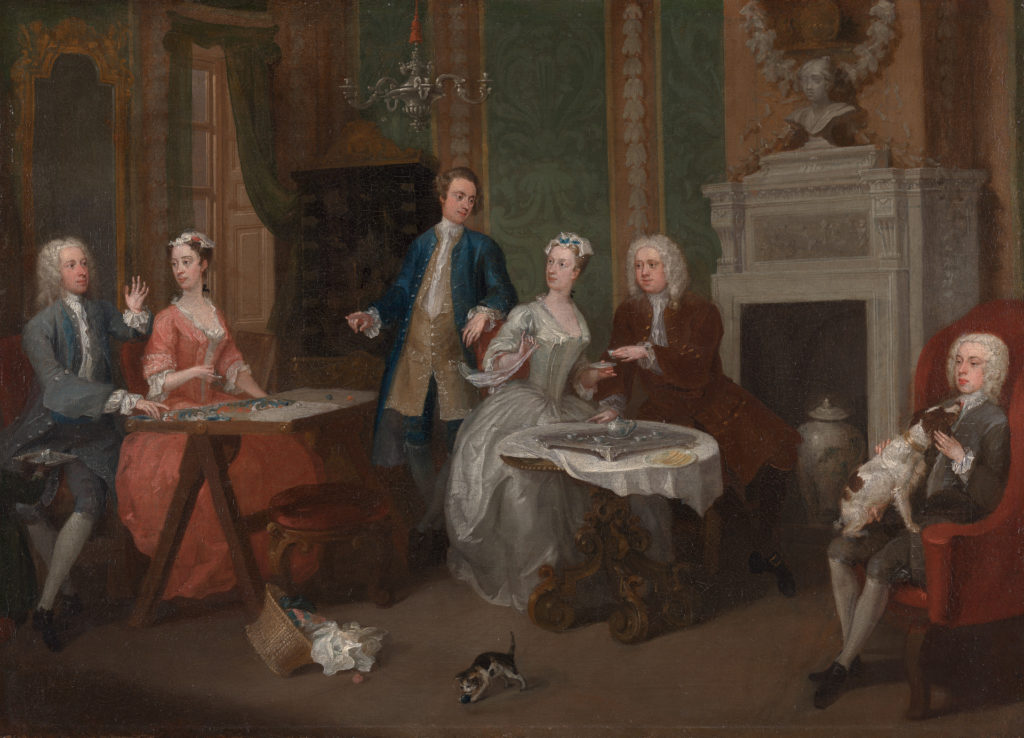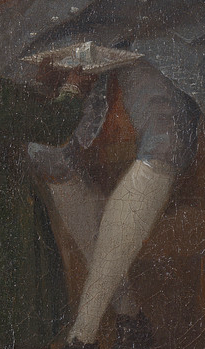This essay discusses the interactive timeline exploring Blackness, Immobility, & Visibility in Europe (1600-1800) launched on Journal18 in September 2020.


With most of his figure cut out of the painting sometime after its completion, only the outstretched right arm of an unnamed black attendant remains on the lower left of William Hogarth’s Portrait of a Family (1735) (Figs. 1 and 2). Reduced to a gesture of servitude on behalf of the white sitters organized along the painting’s horizontal plane, the attendant’s limb might appear marginal at best. Yet this change in the composition underscores the matrices of relationality that render his presence integral to it. Unlike the attendant’s solitary arm, four other pairs of hands point, caress, reach, and even signal secretively, as they animate the otherwise unspeaking sitters into a scene of conversation that is vibrant with conviviality and flirtation. Foreclosing the communication of gestures that moves the viewer back and forth across the painting, the gentleman on the right appears, absent-mindedly, to pet his dog. Rather than following this man into his reverie, however, the viewer is led to the attendant through the mirroring of the two figures’ three-quarter postures. The attendant and the overturned silver teacup that he carries are both synecdoches for the global commerce that enables the family members to commerce (meaning, to converse), freely, with their hands. Some hands toil. Others consume and commune freely, however much, as Hogarth’s popular satires of luxury consumption suggest, they may signal their own moral and physical debasement. Cropped at the edge of the painting, the scene of his entrance into the composition, the attendant appears to be delimited from any possibility of becoming a fully embodied person. Although the others in the painting do not even see him, it is his lingering form that calls into question what it might mean to become a painted subject.
In June 2020, Journal18 invited its readers to contribute to a timeline chronicling the representation and regulation of black bodies in Europe, circa 1600-1800. Amid the static yet bewildering conditions of a global pandemic and nearly universal lockdown, renewed calls for racial justice—for the demand that Black Lives Matter—in the wake of the murders of George Floyd, Ahmaud Arbery, and Breonna Taylor, singularly illuminated the racialization of the purportedly universal freedom to cast breath, stretch one’s legs, move of one’s own will. Stark asymmetries in movement—experienced as mobility by some, and by others as displacement or immobility enforced by terror—served as the foundations for the globalizing forces of trade, war, and colonization that connected lives across the world in unprecedented ways during the long eighteenth century. Those histories offer important roots for the inequities and injustices that we observe around us today. They also serve as critical reminders that the association of freedom with whiteness rarely went uncontested. Indeed, they highlight how such exclusion was challenged by the desire for forms of freedom that, far from being transcendental in practice, could be universal in reach. As art history continues to explore meaningful ways to step beyond the limits of Eurocentrism, timelines can offer one avenue for putting artworks, historical events, and actors across the globe in spatial and visual relation to one another. In crowdsourcing a timeline of events and artworks, our goal was to create a pedagogical tool that could enable cross-referential visualization of the juxtapositions and connections through the aforementioned histories.
Thanks to the generous input of our many contributors, this timeline is much more encyclopedic than we as the editors of Journal18 could have achieved on our own. Here, my use of the word “encyclopedic” merits some clarification. While to most contemporary readers, the term now suggests some sense of comprehensiveness, I refer to the cross-referential system of the eighteenth-century Encyclopédie (1751-1772), also a collaborative endeavor. Although vast in the number of volumes that it comprised, the Encyclopédie’s most singular characteristic was its system of cross-reference. Today, it is tempting to seek out entries on individual topics as authoritative pronouncements on what the eighteenth century or the European Enlightenment may have thought about a particular topic. However, the Encyclopédie’s invitation to descend into the rabbit hole of cross-reference proffers a decentered form of knowledge that can be more relational than authoritative. Like the cross-hatchings of the engravings that illustrate entries discussed across its pages, it is from within a web of intersecting lines that a representational form acquires its color and begins to take the shape of an image. It is with such an image in mind that we invite our readers to explore the webs of relation that this timeline might help make visible.
There are, however, continuities and conventions that give the timeline its present form, and I discuss some of these below in terms of content and practical concerns for our readers’ clarification.
Timeline Content
- Although the contributions we received ranged from 1460 to 1884, we have decided to bracket the timeline, out of practicality and per our initial call, from 1596-1804. We do so also to underscore the specificity of the webs of global exchange that put Europeans in unprecedented densities of contact with Asians, Africans, and Americans from the end of the sixteenth century, setting into motion the accelerated displacement and dispossession of the latter for the enrichment of the former. We end with the date of Haitian Independence, as the nineteenth-century histories of abolition, emancipation, and self-determination demonstrate their own periodized concerns and possibilities.
- The timeline illuminates how, within European conventions, designations of blackness were not limited to the diverse populations of Africans or Afro-Caribbean peoples. From the mid-seventeenth century onwards, debates in religious philosophy about whether or not mankind descended from one race (monogenesis vs. polygenesis), and whether climate marked qualitative differences across people living in different parts of the world, seeped into emerging scientific discourses about racialized difference (e.g. 1655; 1664; 1684; 1790; 1794). At the same time, travelogues and allegories of the four continents often blurred the distinctions between Asians, Africans, and Americans (e.g. 1605; 1612). The term blackness also appears frequently within British colonial records to describe South Asians, both elite and non-elite. That South Asian attendants (e.g. 1765; 1771) often accompanied Europeans who returned to Europe following their sojourns on the Indian subcontinent, or served in households with connections to the region, complicates the prevailing tendency to identify black sitters as ubiquitously African or Afro-Caribbean subjects alone. As the example of Bell (see also 1771) demonstrates, this South Asian woman, pronounced enslaved by a court decision, was sent from Britain to work in a plantation in North America decades before systems of indentured labor were put into place during the nineteenth century.
- In setting events and objects in relation to one another, our aim is to underscore—through the spatial proximities of a timeline—historical affinities that can allow us to connect works of art with what we are learning to discern in the archives. Black subjects appear across a diverse range of artworks in the timeline, such as, but not limited to: religious paintings (e.g. 1609; 1619; 1634); individual portraits (e.g. 1609; 1748; 1768; 1773); and allegories of the four continents (e.g. 1614; 1724; 1752). The timeline also identifies: colonial regulations (e.g. 1718 and 1777) that restricted the movement of black individuals, both in Europe and at sites of empire; rebellions by enslaved groups (e.g. 1749; 1760; 1791); lawsuits with which enslaved individuals claimed their freedom (e.g.1716; 1772; 1778); and court decisions that upheld the continuing identification of black bodies as property (e.g. 1771; 1783).
- Immobility (see 1718; 1786) is as operative a term for our timeline as blackness. It is in relation to emerging notions of property and possession in the seventeenth and eighteenth centuries that some bodies were endowed with the privilege of travel and movement. Others, identified as property or incapable of forming property, or both, were subject to violent dispossession and displacement over and over again. Central to this history of displacement and dispossession is the rape and reproductive labor of black and indigenous women. Indeed, the lived experience of global contact during the seventeenth and eighteenth centuries (e.g. 1662; 1779; 1787) points persistently to a history of interracial sex and sexual violence. To discern blackness or, indeed, whiteness, within these histories is thus to remain alert to mythologies of racial purity.
Practicalities
- Recent curatorial and scholarly efforts have admirably restored names to sitters of artworks who were previously made anonymous. We add to that effort by embracing the convention “now unnamed attendant” in lieu of “black page/servant/enslaved servant” to underscore that names are now unknown to us because of processes of erasure. Attendant, with its etymological tie to a sense of awaiting, also has the potential to subvert the function of servitude and docility often attributed to such figures. It elucidates instead the intransigent subjects who hovered in households that they wished anything but to serve. Indeed, not all black subjects attended. Setting fire to plantations, towns, and houses, and often running away, many seized their own presents, however precariously and fugitively, in striving towards alternative futures.
- We have provided explanatory text in only a few instances, especially if an event or an object does not find many corollaries elsewhere in the timeline. Instead, we have opted to provide references to sources for additional reading where possible, and especially to highlight the work of BIPOC scholars.
- We had to leave out some contributions to the timeline in the absence of working image links or due to incomplete information about the object. We have tried our best to observe continuity in captioning conventions, but some differences were unavoidable in a crowdsourced project. We welcome the feedback of our readers should you note any errors or wish to propose any modifications.
Other Resources
This timeline participates within a wider set of efforts to foreground the histories of blackness in early modern and modern Europe. Three projects with efforts complementary to our own are:
- The interactive timeline and accompanying digital media created for the Yale Center for British Art’s Fall 2014 exhibition, “Figures of Empire: Slavery and Portraiture in 18th-Century Atlantic Britain”
- The Branch Collective’s sampling of essays on race for scholars and students of Victorian Studies
Cite this note as: Zirwat Chowdhury, “Blackness, Immobility & Visibility in Europe: A Digital Collaboration,” Journal18 (September 2020), https://www.journal18.org/5199.
Licence: CC BY-NC
Journal18 is published under a Creative Commons CC BY-NC International 4.0 license. Use of any content published in Journal18 must be for non-commercial purposes and appropriate credit must be given to the author of the content. Details for appropriate citation appear above.
